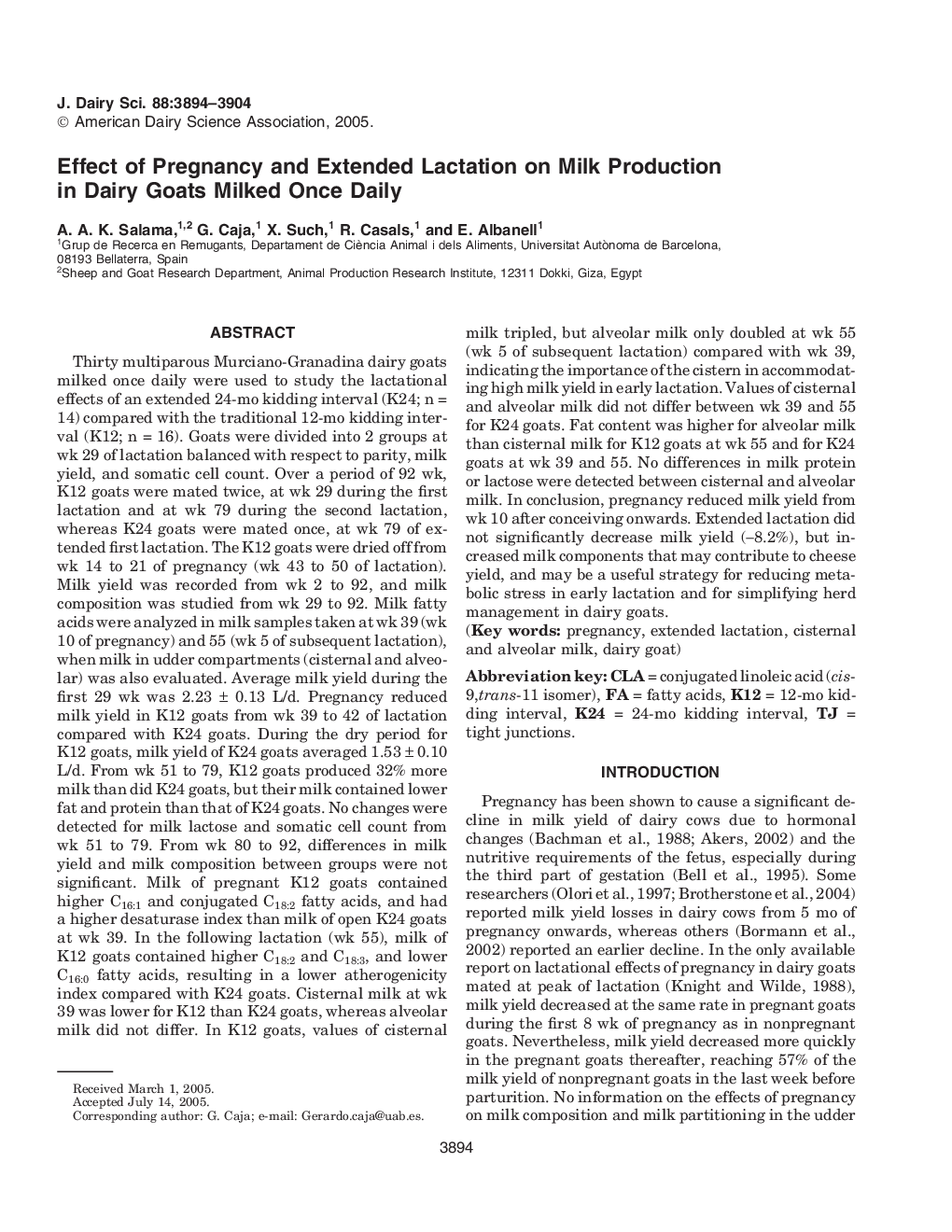| کد مقاله | کد نشریه | سال انتشار | مقاله انگلیسی | نسخه تمام متن |
|---|---|---|---|---|
| 2441891 | 1108155 | 2005 | 11 صفحه PDF | دانلود رایگان |

Thirty multiparous Murciano-Granadina dairy goats milked once daily were used to study the lactational effects of an extended 24-mo kidding interval (K24; n = 14) compared with the traditional 12-mo kidding interval (K12; n = 16). Goats were divided into 2 groups at wk 29 of lactation balanced with respect to parity, milk yield, and somatic cell count. Over a period of 92 wk, K12 goats were mated twice, at wk 29 during the first lactation and at wk 79 during the second lactation, whereas K24 goats were mated once, at wk 79 of extended first lactation. The K12 goats were dried off from wk 14 to 21 of pregnancy (wk 43 to 50 of lactation). Milk yield was recorded from wk 2 to 92, and milk composition was studied from wk 29 to 92. Milk fatty acids were analyzed in milk samples taken at wk 39 (wk 10 of pregnancy) and 55 (wk 5 of subsequent lactation), when milk in udder compartments (cisternal and alveolar) was also evaluated. Average milk yield during the first 29 wk was 2.23 ± 0.13 L/d. Pregnancy reduced milk yield in K12 goats from wk 39 to 42 of lactation compared with K24 goats. During the dry period for K12 goats, milk yield of K24 goats averaged 1.53 ± 0.10 L/d. From wk 51 to 79, K12 goats produced 32% more milk than did K24 goats, but their milk contained lower fat and protein than that of K24 goats. No changes were detected for milk lactose and somatic cell count from wk 51 to 79. From wk 80 to 92, differences in milk yield and milk composition between groups were not significant. Milk of pregnant K12 goats contained higher C16:1 and conjugated C18:2 fatty acids, and had a higher desaturase index than milk of open K24 goats at wk 39. In the following lactation (wk 55), milk of K12 goats contained higher C18:2 and C18:3, and lower C16:0 fatty acids, resulting in a lower atherogenicity index compared with K24 goats. Cisternal milk at wk 39 was lower for K12 than K24 goats, whereas alveolar milk did not differ. In K12 goats, values of cisternal milk tripled, but alveolar milk only doubled at wk 55 (wk 5 of subsequent lactation) compared with wk 39, indicating the importance of the cistern in accommodating high milk yield in early lactation. Values of cisternal and alveolar milk did not differ between wk 39 and 55 for K24 goats. Fat content was higher for alveolar milk than cisternal milk for K12 goats at wk 55 and for K24 goats at wk 39 and 55. No differences in milk protein or lactose were detected between cisternal and alveolar milk. In conclusion, pregnancy reduced milk yield from wk 10 after conceiving onwards. Extended lactation did not significantly decrease milk yield (−8.2%), but increased milk components that may contribute to cheese yield, and may be a useful strategy for reducing metabolic stress in early lactation and for simplifying herd management in dairy goats.
Journal: Journal of Dairy Science - Volume 88, Issue 11, November 2005, Pages 3894–3904